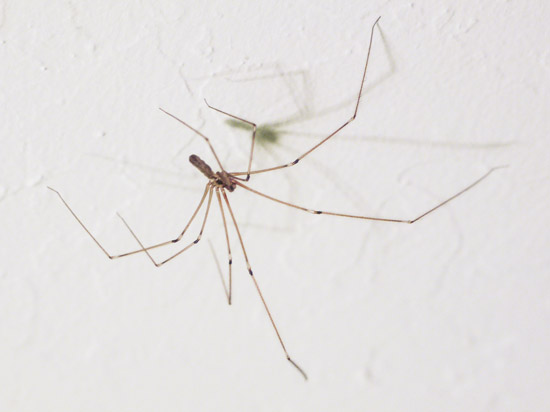
Spiders
the Helpful Hunters

Spiders
the Helpful Hunters

Spiders
the Helpful Hunters
Contents
Only a few spiders are dangerous
There are more than 3,000 species of spiders in the U.S., but few are dangerous or even have mouthparts strong enough to pierce human skin. If you think you have a spider bite, it’s more likely a bite from a flea, tick, mosquito, or mite—or a skin condition.
Spiders are helpful creatures, and very few of them bite! Because they eat large quantities of insects, you should probably tolerate them around home and garden if you can. Spiders are not insects. They are classified as arachnids and have eight legs. Insects have six legs.
Keeping spiders away from your house
Inside your home
- Catch the spiders you find in a container, cover with a piece of paper, and release outside.
- Get rid of messy spider webs by periodically vacuuming with a crevice tool. If some spiders escape, know that they’ll continue to eat bugs in your house.
- Reduce spiders’ food supply. What are those spiders eating? If they’re going after fruit flies, try storing ripening fruit in paper bags that are folded over twice and sealed with a large clip.
- Keep spiders out of the house. Caulk cracks and crevices. Install doorsweeps under doors and screens on windows.
Outside your home
Don’t spray your garden or around the outside of your house to kill spiders. Sprays generally don’t last long and will not affect spiders unless there’s direct contact. Outdoors, spiders provide a very useful pest control service. Leave them to do their job!
- Use a cobweb brush to remove spiders and webs from the side of your hose and under eaves. You’ll find these brushes at hardware stores and garden centers. Look for brushes that have telescoping handles and and soft, microfiber bristles.
- Consider replacing your porch light with a yellow bulb. The yellow light will attract fewer insects, so the spiders that feast on them will also stay away from your door.
Harmless, helpful spiders
These common spiders hunt down garden pests.








Black widow spiders

The few poisonous spider species found in California are not aggressive, and are rarely encountered by people. The dreaded brown recluse spider lives in the Midwest and South, not in California. And in fact, brown recluse spiders are less of a problem where they live than black widows are here.
Black widow spiders hide during the day and come out at dusk to wait in their webs for prey. The black widow found in California is the shiny native, Latrodectus hesperus. The female sports a red hourglass-shaped mark on the underside of her abdomen.
Black widow bites are painless or may feel like a pinprick. They can cause flu-like symptoms for a few days, or in some cases, painful muscle spasms. If you think you’ve been bitten, ice the bite and call the California Poison Control System at 800-222-1222. If your symptoms are severe, go to the emergency room where you can get an injection of an anti-venom serum, which should start working within 30 minutes.
If you can, capture the spider. Drop it into a small jar of rubbing alcohol and take it with you for identification.
Where are black widows found?
- Near the ground, in protected crevices in and around buildings, such as lower portions of seldom-used cupboards, closets, or other dark, dry storage areas
- In woodpiles, lumber piles, or rock piles
- In stacked outdoor furniture, flower pots, or baskets
- Inside the hollow parts of outdoor furniture or stair railing
- In water meter boxes and irrigation control boxes
How to avoid bites from black widows
- Wear gloves to clean up garages, debris, or woodpiles outside, and undisturbed storage areas and piles of clutter inside.
- If you live in an area where these spiders are common, check your bed before getting in, don’t leave clothing on the floor, and shake out your shoes before putting them on.
- Teach children not to tease spiders in their webs or to poke bare fingers into dark cracks and crevices.
Other widows
- The brown widow spider, Latrodectus geometricus, lives in Southern California and is a mottled brownish yellow. Its bite is much less toxic to humans than the black widow’s and rarely needs any medical attention. The good news is that in some areas, the brown widow is running the black widow out of town.
- The false black widow, Steatoda grossa, is smaller than the true widow and the females never have red coloration on their belly. They’re more likely to live indoors, but their bites are relatively mild.
For more information about black widows, brown widows, and false black widows, go to www.ipm.ucdavis.edu and click on Home, Garden, Turf & Landscape Pests. Then click on Pests that sting, bite, or injure and find Black Widow and Other Widow Spiders.
 The few poisonous spider species found in California are not aggressive, and are rarely encountered by people. The dreaded brown recluse spider lives in the Midwest and South, not in California. And in fact, brown recluse spiders are less of a problem where they live than black widows are here.
The few poisonous spider species found in California are not aggressive, and are rarely encountered by people. The dreaded brown recluse spider lives in the Midwest and South, not in California. And in fact, brown recluse spiders are less of a problem where they live than black widows are here.
Black widow spiders hide during the day and come out at dusk to wait in their webs for prey. The black widow found in California is the shiny native, Latrodectus hesperus. The female sports a red hourglass-shaped mark on the underside of her abdomen.
Black widow bites are painless or may feel like a pinprick. They can cause flu-like symptoms for a few days, or in some cases, painful muscle spasms. If you think you’ve been bitten, ice the bite and call the California Poison Control System at 800-222-1222. If your symptoms are severe, go to the emergency room where you can get an injection of an anti-venom serum, which should start working within 30 minutes.
If you can, capture the spider. Drop it into a small jar of rubbing alcohol and take it with you for identification.
Where are black widows found?
- Near the ground, in protected crevices in and around buildings, such as lower portions of seldom-used cupboards, closets, or other dark, dry storage areas
- In woodpiles, lumber piles, or rock piles
- In stacked outdoor furniture, flower pots, or baskets
- Inside the hollow parts of outdoor furniture or stair railing
- In water meter boxes and irrigation control boxes
How to avoid bites from black widows
- Wear gloves to clean up garages, debris, or woodpiles outside, and undisturbed storage areas and piles of clutter inside.
- If you live in an area where these spiders are common, check your bed before getting in, don’t leave clothing on the floor, and shake out your shoes before putting them on.
- Teach children not to tease spiders in their webs or to poke bare fingers into dark cracks and crevices.
Other widows
- The brown widow spider, Latrodectus geometricus, lives in Southern California and is a mottled brownish yellow. Its bite is much less toxic to humans than the black widow’s and rarely needs any medical attention. The good news is that in some areas, the brown widow is running the black widow out of town.
- The false black widow, Steatoda grossa, is smaller than the true widow and the females never have red coloration on their belly. They’re more likely to live indoors, but their bites are relatively mild.
For more information about black widows, brown widows, and false black widows, go to www.ipm.ucdavis.edu and click on Home, Garden, Turf & Landscape Pests. Then click on Pests that sting, bite, or injure and find Black Widow and Other Widow Spiders.
Common home and garden pesticides are found in stormwater runoff, treated wastewater, and in local waterways, sometimes at levels that can harm sensitive aquatic life. Our Water Our World, sponsor of this website, is a joint effort by water pollution prevention agencies, participating retail stores, and pesticide distributors and manufacturers — working together to reduce the risks associated with pesticide use.
This website is provided as a public service. No endorsement of specific brand name products is intended, nor is criticism implied of similar products that are not mentioned.

